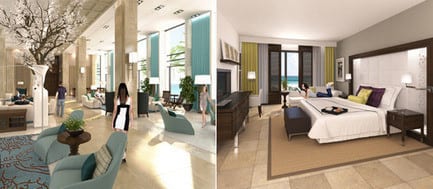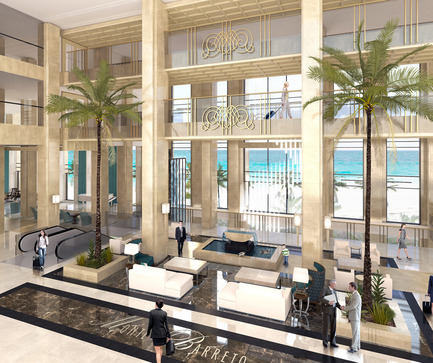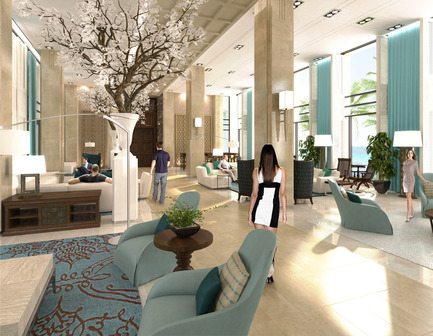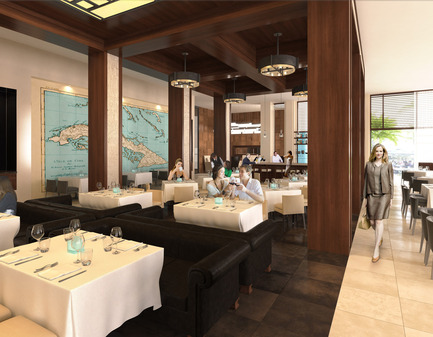

CDID-ARCOP: A partnership that sees the big picture
CDID-ARCOP
Montreal, Canada, 2010-08-12 –
The ARCOP Group and CDID DESIGN are announcing the creation of a new entity, CDID-ARCOP. This amalgamation of the international architectural firm and the interior design firm is taking the form of an autonomous structure specializing in interior design that will complement the architectural services of ARCOP’s Montreal division. The founder of CDID DESIGN, Pascale Vaillancourt, a rare interior designer with more than 25 years of experience in the hotel and restaurant sector, is the new president of CDID-ARCOP. At the same time, CDID DESIGN will continue to offer its usual interior design services.
A historic encounter
It was while working on a mandate in Cuba in 2005, involving the design of a large five stars (700 keys) hotel complex in Havana, that the ARCOP Group and CDID DESIGN worked together for the first time. When the project was successfully completed and enthusiastically received by the client, it was obvious that this chance association should become a permanent partnership. “We speak the same language,” observes Robert LaPierre, a partner at ARCOP. “She understands space as an architect would.”
In fact, since the events of September 11, 2001, the hotel industry has tended more to want refurbishment of existing facilities and, in particular, changes to the interior design of hotels. The ARCOP Group, often a trendsetter (see below), quickly saw the need to add a structure specializing in interior design. This was even more pressing because, although the architectural firm executes projects in a number of sectors (commercial, residential, institutional), it is internationally recognized for its expertise in the hospitality industry (hotels, conference centres, recreational centres, spas, etc.).
Expertise in the hospitality industry
The ARCOP Group has to its credit the design, refurbishment, expansion and construction of numerous hotels around the world, including the Queen Elizabeth in Montreal, the expansion of the Château Frontenac in Quebec City, and the Fairmont at Mont Tremblant. But, far from being content with an unassailable reputation in Quebec, the group has projects throughout Canada, including the Montreal Sheraton Centre-Ville and other hotel chains such as Intercontinental, Hilton, Delta and others. In the Middle East, Asia, and the Caribbean, the architectural firm very early distinguished itself by gaining the confidence of groups such as Serena and Jaypee (India, Pakistan, Afghanistan), Gems (Barbados), Pearl Continental (India, Libya), and Diamond Peninsula (China). “More than 35% of our projects relates to hospitality,” comments Robert LaPierre.
For its part, CDID DESIGN has not been idle. Thanks to its spirited president, the firm has designed the interior of numerous major hotels. In fact, when she was senior designer at Camdi Design, Vaillancourt created the interior design for the very first boutique hotel in Canada, Groupe Germain’s Germain-des-Prés (now part of the ALT banner), which opened in 1988. Since then, with her strong sense of space and harmony, she has executed a wide variety of mandates, from the very classic Le St-James (in collaboration with Jacques Bouchard) and Résidences Le Lux for Les Hotels Gouverneur, to transitional style for condo hotels for Intrawest and the Hotel complex Le Château Bonne Entente in Quebec City, and the current contemporary and cool renovation of the popular Bond Place Hotel in Toronto.
The synergy of two complementary bodies of expertise
The creation of CDID-ARCOP capitalizes on the know-how of both firms, by combining the flexible design and originality of CDID Design and the experience and resources of the ARCOP group. “It’s a creation process done in a tight collaboration,” explains Vaillancourt. “For each project, we discuss the best orientations to take and plan the spaces by combining our expertise and talent.”
The direct consequence of this synergy is that CDID-ARCOP has the means to design spaces in which architecture and interior design are perfectly integrated. “We are not content with ornamenting an interior,” notes Vaillancourt. “We intervene at the level of the interior architecture of a project to create spaces in harmony with their architectural environment , taking in consideration the client’s wishes.”
ARCOP: Ahead of its time
With its 55 years of experience, the ARCOP Group is a pillar of architecture in Quebec. Yet, it is often believed (mistakenly) that age and creativity don’t go together. Yet the ARCOP Group has always kept up to date by adapting to trends and even, often, being a step ahead.
In the 1960s, projects such as Place Ville-Marie and Place Bonaventure were beacons for a new concept in urban planning, mega-complexes (“cities within cities”), bringing together offices, businesses, and impressive (for the time) underground walkways. With the refurbishment of Maison Alcan in 1983, ARCOP inaugurated in Canada an architectural movement that integrated heritage buildings into new commercial structures. In the same decade, the group stood out by internationalizing before others. An office was opened in New Delhi even before the offices in Toronto and Boston were established.
Today, with its 300 employees, ARCOP is established around the world, from Canada to China, the Caribbean, India, and Pakistan. This international presence also fits with the group’s tradition of openness, with its emphasis on respect for human, cultural, and social values. From the start, ARCOP’s strength has been building a successful firm with founders who were very representative of the Canadian ethnic mosaic. In spite of their cultural differences, they shared a common vision for high-quality architecture produced with respect for others.
This tradition endures today with projects that testify to the ARCOP Group’s sensitivity to the cultural and historical specificities of environments and buildings. Among the most convincing examples are the Legislative Assembly building for the Nunavut government, the Serena Hotel in Kabul, Afghanistan, the Monte Barreto hotel complex project in Cuba, and the expansion of Château Frontenac in Quebec City.
In addition, the group benefits from the dynamism and creativity of designers with an average age of under 35, building on the expertise and experience of generations of partners who have given ARCOP its strength, based on an ability to listen and a visionary spirit. It is no accident that today the group is involved with major projects such as the new hospital centres for the Université de Montréal (CHUM) and the Glen Campus of McGill University (CUSM), the renovation of the west wing of the Parliament Buildings in Ottawa, and the Qujing techno-park in China.
CDID DESIGN: An intuition for interior space
The new president of CDID-ARCOP has almost 30 years of experience in interior design. When she created CDID DESIGN in 1996, she laid a foundation for an original style, inventing spaces with a strong personality, while respecting their history and the needs of their users.
She quickly gained recognition for her work, including a large collection of awards from the Commerce Design Montréal competition for designs such as Les Halles de la Gare in Montreal’s Central Station, the restaurant Opus II, Green Café, and Hôtel Le St-James.
Pascale Vaillancourt likes to take a hands-on approach. She designed the luxurious interior for the restaurant Nuances (5 diamonds) at the Casino de Montréal and created the warm, relaxed atmosphere and the original image implemented for many Café Java U. She inaugurated the first Presse Café in Paris, France, created the first image of Presse Café for Australia, and collaborated with Van Houtte. She invented the sparkling image of the Green Cafés, and adapted to the mandate for restraint and classicism at Hôtel Le St-James. “We adapt to our clients’ age, budget, and style,” she explains simply.
For Vaillancourt, the secret of a successful space is in observing the character of a site and listening to her client’s expectations. That is what was pleased the client in her proposal for the interior design of the Monte Barreto hotel complex in Havana. In addition of imposing a contemporary style, she integrated characteristic elements of Art Deco and Colonial styles, into the new building to establish a dialogue with the city’s Art Deco and Colonial historical architecture. It was a question of evoking, rather than imitating, the styles of another era. Vaillancourt retained only their essence, such as the Art Deco’s verticality, spatial symmetry, and ostentatious ways of presenting works of art, mixed with refined Colonial antiques, integrated in a contemporary envelope.
She explains this intuition about spaces, which is her forte, with a modest comment: “In Quebec, we know how to do a great deal with a small budget : it inspires us to adapt and be creative!”
– 30 –
-
-
Sylvie Trudeau
-
[email protected]
-
514.878.3941

CDID-ARCOP

CDID-ARCOP

CDID-ARCOP

CDID-ARCOP




